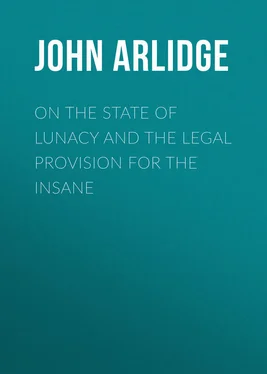John Arlidge - On the State of Lunacy and the Legal Provision for the Insane
Здесь есть возможность читать онлайн «John Arlidge - On the State of Lunacy and the Legal Provision for the Insane» — ознакомительный отрывок электронной книги совершенно бесплатно, а после прочтения отрывка купить полную версию. В некоторых случаях можно слушать аудио, скачать через торрент в формате fb2 и присутствует краткое содержание. ISBN: , Жанр: foreign_antique, foreign_prose, на английском языке. Описание произведения, (предисловие) а так же отзывы посетителей доступны на портале библиотеки ЛибКат.
- Название:On the State of Lunacy and the Legal Provision for the Insane
- Автор:
- Жанр:
- Год:неизвестен
- ISBN:http://www.gutenberg.org/ebooks/44320
- Рейтинг книги:3 / 5. Голосов: 1
-
Избранное:Добавить в избранное
- Отзывы:
-
Ваша оценка:
- 60
- 1
- 2
- 3
- 4
- 5
On the State of Lunacy and the Legal Provision for the Insane: краткое содержание, описание и аннотация
Предлагаем к чтению аннотацию, описание, краткое содержание или предисловие (зависит от того, что написал сам автор книги «On the State of Lunacy and the Legal Provision for the Insane»). Если вы не нашли необходимую информацию о книге — напишите в комментариях, мы постараемся отыскать её.
On the State of Lunacy and the Legal Provision for the Insane — читать онлайн ознакомительный отрывок
Ниже представлен текст книги, разбитый по страницам. Система сохранения места последней прочитанной страницы, позволяет с удобством читать онлайн бесплатно книгу «On the State of Lunacy and the Legal Provision for the Insane», без необходимости каждый раз заново искать на чём Вы остановились. Поставьте закладку, и сможете в любой момент перейти на страницу, на которой закончили чтение.
Интервал:
Закладка:
The proportion of recoveries above stated, is calculated upon cases of less than a year’s duration. Let us see what can be effected in England under conditions as similar as practicable, though not equally advantageous. The most satisfactory results we can point to are those obtained at St. Luke’s Hospital, London, where the cures have averaged 62 per cent. upon the admissions during the last ten years. At this and likewise at Bethlehem Hospital, the rules require that the disorder be not of more than one year’s duration at the time of application for admission, and that it be not complicated with epilepsy or paralysis, maladies which so seriously affect its curability. Such are the conditions favourable to a high rate of recoveries enforced by rule. On the other hand, there are at St. Luke’s not a few circumstances in operation prejudicial to the largest amount of success possible. Its locality is objectionable, its general construction unfavourable, its grounds for exercise and amusement very deficient, and the means of employment few. But apart from these disadvantages, so prejudicial to its utility and efficiency, there are other causes to explain its ratio of success being less than that estimated by our American brethren to be practicable. Though the rule excludes patients the benefit of the hospital if their disease be of more than a year’s duration, yet from the great difficulties attending in many cases the inquiry respecting the first appearance of the insanity; its sometimes insidious approach; the defect of observation, or the ignorance, and sometimes the misrepresentations of friends, resorted to in order to ensure success in their application to the charity, older cases gain admission. Again, of those admitted in any year, there are always several whose disorder is known to be of nine, ten, or eleven months’ duration, and at least a fourth in whom it is of six months’ date and upwards. Further, although the rules exclude epileptics and paralytics, yet at times the history of fits is withheld by the patients’ friends, or the fits are conceived to be of a different character, or the paralysis is so little developed as not to be very recognizable; and as in all ambiguous cases, – whether it be the duration or the complication of the mental disorder which is in doubt, the Committee of the Hospital give the benefit of the doubt to the patient, – the consequence is, that several such unfavourable cases are received annually. On referring to the statistical tables of the institution, these “unfit” admissions are found to amount to 10 per cent.
We have thought these details desirable, on the one hand, to account for the difference in the ratio of cures attained in St. Luke’s compared with that fixed by American writers; and on the other, to show that though the rate of recoveries at that London Hospital is highly gratifying, it might be rendered yet more so if certain impediments to success were removed, and that similar benefits could be realized elsewhere if due provision were made for the early and efficient treatment of the malady.
Were we at all singular in the assertion of the curability of insanity, we should endeavour to establish it by an appeal to the statistics of recoveries among recent cases in the different English asylums; but instead of advancing a novel opinion, we are only bearing witness to a well-recognized fact substantiated by general experience. This being so, it would be fruitless to occupy time in quoting many illustrations from Asylum Reports: one will answer our purpose.
At the Derby County Asylum, under the charge of Dr. Hitchman, a high rate of cures has been reached. In the Third Report that able physician writes (p. 5), – “It cannot be too often repeated, that the date of the patient’s illness at the time of admission is the chief circumstance which determines whether four patients in a hundred, or seventy patients in a hundred, shall be discharged cured. Of the 151 cases which have been admitted into the asylum during the past year, eleven only have been received within a week of the onset of their malady; of these eleven, ten have been discharged cured, – the other has been but a short time under treatment.” In his Sixth Report (1857, p. 22), the same gentleman observes, – “The cures during the past year have reached 60 per cent. upon the admissions; but the most gratifying fact has been, that of twenty patients, unafflicted with general paralysis, who were admitted within one month of the primary attack of their maladies, sixteen have left the asylum cured, – three are convalescent, and will probably be discharged at the next meeting of the Committee, and the other one was in the last stage of pulmonary consumption when she came to the asylum, and died in three weeks after her admission.”
After this review of what may be effected in restoring the subjects of mental disorder to reason and society, to their homes and occupations, by means of early treatment, it is discouraging to turn to the average result of recoveries on admissions obtained in our County Asylums at large. This average may be taken at 35 per cent., and therefore there will remain of every 100 patients admitted, sixty-five, or, after deducting 10 per cent. of deaths, fifty-five at the end of the year. This number, fifty-five, might fairly be taken to represent the annual per centage of accumulation of the insane in asylums, were the data employed sufficient and satisfactory. But so far as we have yet examined the point, this proportion is larger than a calculation made over a series of years, and may be approximatively stated at 35 per cent. on the admissions.
How great would be the gain, alike to the poor lunatic and to those chargeable with his maintenance, could this rapid rate of accumulation be diminished, by raising that of recoveries, or, what is tantamount to it, by securing to the insane prompt and efficient care and treatment! How does it happen that this desideratum is not accomplished by the asylums in existence? what are the impediments to success discoverable in their organization and management, or in the history of their inmates prior to admission? and what can be done to remedy discovered defects, and to secure the insane the best chances of recovery? Such are some of the questions to be next discussed.
Chap. V. – on the causes diminishing the curability of insanity, and involving the multiplication of chronic lunatics
In the preliminary chapters on the number and increase of the insane in this country, we limited ourselves to determine what that number and that increase were, and entered into no disquisition respecting the causes which have operated in filling our asylums with so many thousands of chronic and almost necessarily incurable patients. Nor shall we now attempt an investigation of them generally, for this has been well done by others, and particularly by the Lunacy Commissioners in their Ninth Report, 1855; but shall restrict ourselves to intimate that the increase of our lunatic population, mainly by accumulation, is due to neglect in past years; to the alteration of the laws requiring the erection of County Asylums for pauper lunatics generally; to the collection and discovery of cases aforetime unthought of and unknown; to the extension of the knowledge of the characters and requirements of the insane both among professional men and the public; and, lastly, to the advantages themselves of asylum accommodation which tend to prolong the lives of the inmates.
Such are among the principal causes of the astounding increase in the number of the insane of late years, relatively to the population of the country, some of which fortunately will in course of time be less productive. Those, however, which we now desire to investigate, are such as directly affect the curability of insanity, either by depriving its victims of early and efficient treatment, or by lessening the efficiency and usefulness of the public asylums.
Читать дальшеИнтервал:
Закладка:
Похожие книги на «On the State of Lunacy and the Legal Provision for the Insane»
Представляем Вашему вниманию похожие книги на «On the State of Lunacy and the Legal Provision for the Insane» списком для выбора. Мы отобрали схожую по названию и смыслу литературу в надежде предоставить читателям больше вариантов отыскать новые, интересные, ещё непрочитанные произведения.
Обсуждение, отзывы о книге «On the State of Lunacy and the Legal Provision for the Insane» и просто собственные мнения читателей. Оставьте ваши комментарии, напишите, что Вы думаете о произведении, его смысле или главных героях. Укажите что конкретно понравилось, а что нет, и почему Вы так считаете.












